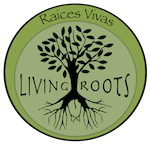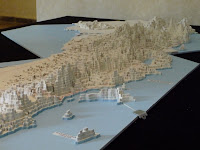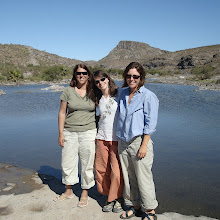Que Pasa Aqui (What’s Happening Here)
The Heat of summer is finally settling in. We are back, after two weeks being out of communication in the mountains, where we were visiting and interviewing several isolated ranching communities in the San Javier area. Our days were filled with travel over bumpy, dusty dirt roads with nothing but cactus, rocks and sun for miles around. The sight of a cow or goat nibbling desert brush is a sign that you have reached “civilization” in the form of the ranch. Now you feel that you have reached a refuge, with small tended flower gardens, perhaps trees for shade, but always near a water source, reflecting the saying we hear everywhere and have never felt more true: “agua es vida” (water is life).
Above: View of El Jarrial Ranch
Below: "Posa" (swimmable oasis)
Now we are back in the city, sitting in our upstairs room at Baja Paradise, our favorite hostel in La Paz, doors open, fan swirling. We dropped back into town for a special event that was co-sponsored by one of our local partners, Niparaja, a prominent local conservation organization. Specialists from all over the state convened to talk about the importance of the Sierra La Guadalupe and the Sierra La Giganta in terms of their cultural and historical significance, ecologically unique oases, endemic flora and fauna, and the scarce water supply that provides fresh water for much of the state.
Perfect Timing
We have arrived at a critical time. The experts at the conference implored the need to learn from sierra ranching communities, who are now the sole keepers of indigenous knowledge and have adapted to live in equilibrium with their harsh, arid environment. Political primary elections are approaching, and the hope was to enamor politicians to carry the banner of protecting the Sierras as a biosphere reserve in their campaigns.
Ultraviolet water filter
The proposed biosphere reserve is catalyzing the world of NGOs, governmental agencies and academics to listen to what historians have been saying for decades, that this culture of “Antigua Californios” could flicker out within a handful of generations. The majority of young people are leaving because it is nearly impossible to make enough money from a land with inconstant water. For those who want to further their education, youth see no options for combining their degree with the remote ranch life.
While many academics and professionals were discussing the future of the sierra in an air conditioned conference room in La Paz, a paved highway creeps feet closer to reaching San Javier in the heart of the Sierra. Electricity is 15 days away and families are preparing to buy TVs, fans and refrigerators. They tell us it is a blessing, but they also wonder, “How will this change us?”
Dario tooling a piece of leather and showing his 1 year old grandson the ropes.
Challenges on the Ranch
Every day our understanding of the complexities of “la vida ranchera” (ranch life) become more clear. With every cup of sweetened, dark coffee offered to us under palm thatch shade, we connect another piece of the puzzle. Prices for onions, the major summer crop, can be miserably low in these months because the market is saturated and there is currently no way to store them. Very few people are curing and tanning leather anymore because the permitting process to use Palo Blanco bark is too difficult. Women have started sewing and embroidery projects, and will actually work well together, unlike the men. However, the materials were given out to them by the government and when they run out, they don’t buy more. Not to mention, many women can’t sew anymore because they need glasses which are too expensive to buy. Children from ranches ride several kilometers into San Javier for school on Mondays and stay there in a dorm until Friday. After school lets out at noon, kids help clean the school, play games and huddle around a single television set to watch soap operas. The customs of ranch life are beginning to fade, especially as kids are only are home on the weekends to learn the ranching way of life from their parents. At 15 years old, they have to make the decision to either stay on the ranch and learn how to plant and raise livestock, or leave the sierra to study.
Conducting a workshop with secondary school students to better understand their hopes for the future and what they feel is special about ranch life.
The Value of “La Vida Ranchera”
The more we learn, the more value we see. Yesterday we enjoyed 100% organic wine from grape vines introduced by the missionaries close to 300 years ago, the best goat cheese we had ever eaten and olives from a backyard orchard. We watched as Maria Gomez Meza carefully wove dried palm fronds into a hat, a process which will take her a month of weaving 3-5 hours everyday and which will result in a work of art for which she has no market. We learned from Dario Higuera how to tool intricate patterns into leather, and make horsehair ropes by twisting black, brown, white and gray tail hair into strands with handmade wooden tools. We learned from his wife, Cipriana, how to toast coffee beans and make goat cheese. Memo informed us of all the healing properties of the nopal cactus (prickly pear), and how to peel and prepare it. Chavalo Velis and his family who has been making sweets out of every kind of fruit imaginable for generations, helped Mila prepare a special lung cleansing tea from a local leaf. Proof that what the sociologists say about the rancheros of Baja California Sur having absorbed the indigenous wisdom of the natives who lived here before them is true.
We have begun connecting a crew of passionate young advocates from each of the sierra communities. While they have all left to study tourism, law or information technology, their hearts are in the sierra and with their communities, and they are committed to protecting the essence of the ranchero life. Together we hope to help others see the value in those things that are pivotal to making the ranchero culture unique. While many new ideas spin around everyday, we keep returning to the ideas of creating some form of marketing cooperative and developing a certification to help package and promote sierra made items, ensuring authenticity, hygiene standards, handmade products etc. We have also been discovering the many possibilities associated with rural tourism, unique opportunities not currently found in the current coastal-based tourism market.
Tony, Dario, and Colleen after a lesson in rope making. Tony was one of our"guest" classmates last semester who has a ranching background and joined us for a week of work.
Coming Up
The next step is a community meeting on Friday. We have invited families from across the San Javier area to participate in an envisioning their future activity and setting a common goal for the community for which we will play a part in.
Our network is growing, our ideas are being validated, we have some committed help and we have been taken in by many a ranch family. Spirits are high and we are looking forward to returning to the Sierra tomorrow.
San Javier baseball game in the heat of the day, where we handed out invitations to our upcoming workshop.


























No comments:
Post a Comment